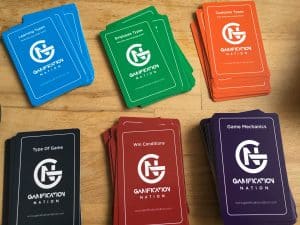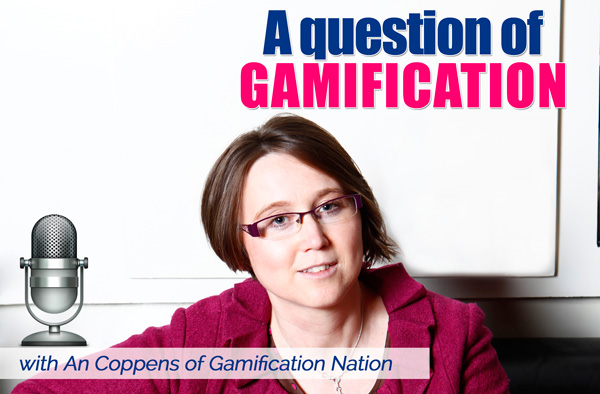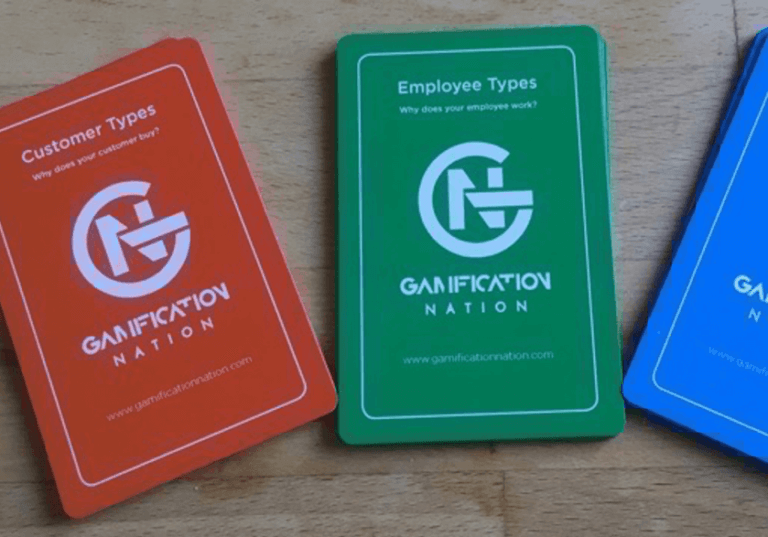Welcome to this week’s a Question of Gamification.
How to use our gamification card deck
And this week’s question is a question from Remco one of our clients who bought a gamification card deck. It’s our physical card deck that we designed a while ago, to help us to explain what game design is all about.
Why we made the card deck
We use it internally but also when we work with people that don’t like games, don’t play games, don’t understand the games or never had anything to do with game design. We also sell it to a lot of people who just basically want to level up their skills and practice their game design. So both audiences buy our gamification decks.
For us, it was very much a solution to a need, because a lot of the time when I did HR workshops, and learning and development workshops, I had people in the room that actually admittedly said, I don’t like games. And I’ve never played games, or only when I had to when I was younger, did I ever play games.
In order to address that, and still bring them along on a journey, where they could actually end up doing a gamification design for their company, I needed a tool. So that’s why the gamification design card deck was born.
1. Choose who you are designing for
The first thing I always say is to find out ‘what it is?’ or aim your design at someone.
Now for the purpose of my HR workshops, the other typical challenge was that every participants audience was different and diverse, which makes it really hard to design something together. So I needed the card set that would address that.
So the first cards that I would ask you to focus is to pick your target audience: learners, employees or customers.(hint they are light blue, green or orange). If you are aiming at learners, you will use the learner types cards. If you are aiming at employees, you choose employee types cards, or if your gamification is aimed at customers and then you use the customer types cards. You only need the cards of the audience you are focusing on, you can leave aside those audience cards which are not your target audience.

Let’s imagine we are working on something for our employees, which means we have the green cards in front of us. Then we just decide, which of these are most likely to be the employees that work for me in the company or work with me in the company. So let’s say we have the corporate career makers that work in the company. So I’ve chosen one card as my core target audience.
Typically, I would say, you can choose however many that apply to your audience, and apply to the people that you have working for you. Because you have a lot of choice available and we’re dealing across customers, learners and employees, one card from these 3 sets is ideal to start with. You can choose more than one, if you’re already a bit confident. Once you have three different types all playing together, what I would say is consider having specific experiences to suit each and every one of those audiences, because what you need for each of them for them to make sense and for it to be good and useful, maybe quite different.
So for the purpose of today, we have a corporate career climbers, so that’s our target audience,
2. Choose a game genre or game type
Every game needs to fit in a category. This is where you use ‘the type of game cards’ (hint: they are dark blue in colour and have type of game on the back). I’ve listed 13 different kinds of games. But there are many more. Mash-ups, where you put two game genres together, can work. What I would suggest here is that you can pick up to maximum two of the type of game types.
If you’re an absolute beginner, I recommend that you pick only one. The reason for that is you want to keep it simple when you start out. Because the game mechanics once you start mashing game types up makes the game more complex. As a knock on effect it makes it harder to create, it makes it harder to do many things.
So imagine that for this purpose. For our career makers, we have a resource management game.
A resource management game is a game where you have to collect items, nurture items, and you have to make sure that you have enough resources to do everything that you need to do. Games like Sim City or like Farmville are the types of resource management games that we’re talking about here.
Then ask your imagination what would help your audience to achieve their goals aka what are the win conditions
For a corporate career maker, what could be the types of things that they would love to collect? Maybe it could be experiences, such as experience to do different types of things within the organization’s. For others it may be levelling up or steps up on the career ladder, because if they want to go from A to the top position, you basically need to help them get there. By giving them things to collect along the way, you may actually provide them that path to get them there. Once you have the game type, you know who you’re aiming it at, the next thing you need to choose is the win conditions. (Hint: you use the maroon or wine coloured cards with win condition on the back)
Every good game has win conditions. You don’t have to stick to the ones that are completely fitting to your game, you can be creative with that. That’s also why there are more win condition cards than there are game types.
Let’s say I’ve picked winning streaks as one of my win conditions and the second win condition is control. So I’ve chosen control.
Up to two or three win conditions are manageable. Anything way beyond that becomes hard. Effectively, you only need one target audience, one type of game and one win condition and you have the bare bones of a game. So effectively, you could stop here.
I could say, well, actually, I have resource management with winning streaks and control as the leverage points and that’s enough. In this case, what we would have is a game where if they have enough winning streaks and winning streaks are things that you get through regularity through consistency. So for example, showing up on time, every every day for six months, practicing a bit of learning every day for an expected an amount of time for an employee could be delivering all your projects in on time, on budget, etc.
Whatever win conditions you choose make sure that it’s relevant to your end user. Always tie your design back to your end user.
Our corporate career climbers will want to know what are they measured on in terms of the winning streaks so that they can climb the ladder. They will want transparency, we need to be able to show, if you do that you will earn the right to this. Always make that something they definitely want.
The other win condition I chose here was control. Basically it tells you that when you win you will have the power to control the territory of the game or power over others. The virtue of leveling up in a corporate career actually would mean that you gain that element of control. But it could be a lot more trivial. It could be that you can deliver karma to other people as in some something good. Or you can take away something negative, you can again be playful around that. These are game mechanics that give the feeling of progress that give the feeling of achievement. That’s why they are called win conditions.
Every simple game from a puzzle to Candy Crush to World of Warcraft, to Fortnite to Minecraft has win conditions. They may be self imposed or they may be explicit. For example, completing a puzzle is effectively the win condition for a puzzle game. Minecraft, it may well be that you have built a fantastic looking item and it’s you that judges it and when it’s built. Then you have to hope that nobody comes and crushes it. In Fortnite, it’s a lot more finite. You get basically ruled out by other players being until there is one person left as the last one standing. To be the one that can do the victory dance is effectively what you will want in a Fortnite situation.
Let’s recap to how far we have come with the cards: as it stands, you have either chosen a customer type, an employee type or a learner type, you have chosen a type of game, and finally you have chosen a win condition or even two win conditions if you want to make it bit more complex.
4. choose your game mechanics
Then you are left with I think it’s about 60 something game mechanics. Game mechanics, are what makes a game interesting. It’s what makes you come back, it’s what makes you play more often, it’s what engages you to take that next level step.
Typically, what I do in workshops is I say you can pick as many as you like, but imagine that each card, each game mechanic costs you 10,000 of whatever money currency that is local to you.
Let’s say we’re in the UK, we have British pounds, so 10,000 pounds per game mechanic card. In the EU, it’s 10,000 Euros; in the US it will be Dollars. You adapt to the local currency and make it a meaningfully high number. Let’s say we can pick five game mechanics because our budget is £50,000. We know we will probably need a little bit of extra for setup, and the already chosen mechanics that we didn’t count for. I set a budget, so that people are forced to be selective. In most games we have a limited number of game mechanics and the more you add, the more expensive it becomes to produce.
So for my example I have picked the following game mechanics: a joker, a treasure hunt, unlocking of new items, a team quest and a boss battle. So those are my five chosen game mechanics for my target audience. That’s my £50,000 budget spent.
Realistically, you can use as many as you like.
With clients I break the selection process down into 4 steps:
1. What are the game mechanics that are going to attract people in? What game mechanics can act as an invite to come and play your game?
2. What are the game mechanics to get them started. These may be tutorial game mechanics or small activities and interactions you have them do to create that initial boost and happiness that comes from and early win. A feeling of “wow, I won!”.
3. What is the first first next step? For this step we are looking for game mechanics to keep people engaged and coming back for more. So you know, you may have a couple of those.
4. Finally then you need to decide if there is an end game. Not every game needs one. For example, in Minecraft or in Lego, there is no end game unless you choose there is an end. But in games, like Fortnite, there is a winner and where there is a winner you will also find a loser. If you are designing games for work, also look at what’s the part of the loser, can they play again? Is it serious? Is it just trivial? Or is it just a game that keeps refreshing every quarter every month every year. There are a few considerations to take into account when you’re using this for business.
Back to our example. Let’s say we have the play a joker card. In a corporate career, you may have moments where you’re so busy, that you may have to play a joker not to lose your place. And because we had these winning streaks as part of our game, it might be really important to have a joker so you can keep your position in the control sense of things.
Then I also picked unlocking of new items. Now, these can be hidden, they can be unlocked through the things you do, so imagine you’ve succeeded at 10 winning streaks in a row or you have achieved 10 consecutive days of achievement. Actually, guess what, that works quite neatly with the control game element that we already had as a win condition because the unlocking of new items can actually give you the control over an area for example. The same with the treasure hunt. I like treasure hunts, I think they’re they’re kind of cute. You can do them with augmented reality, you can do them in reality with clues, you could do them on email, you can do them completely digital. They actually suit a lot of things, if you have a new communications campaign coming out a treasure hunt, could be great fun. But a treasure hunt may also be a way of earning that control in your game. In our resource management game it’s a tool that unlocks maybe special effects, special boosters, because effectively you are collecting treasures which is often standard practice in a resource management game. In job setting that could be competencies, or it could be very job-related items that unlock more responsibility, more abilities as such.
Because we’re dealing with corporate career makers, I added in a bit of a competitive element of boss battle, who knows most or who is best. That’s where you invite a colleague to be in a duel with you. And you decide on, you know, how you battle it out how, who’s the better of the two of you in a chosen area. So it could be about consistency, it could be about control. It could be about knowledge, it could be about projects, you can set it as the game master you you set the controls. But you can also leave an element of freedom to the players where you can say, well look, you know, within reason you can have a boss battle once a quarter on, you know, who knows most and it could be a tournament style.
The one I usually include in game designs for companies is a team quest, where some of the achievements that you earn to win control or to have a winning streak is that you do something for the team. Most organizations I know depend on the team to deliver and to achieve the results. So therefore, team quests work really well. So that’s my five, that’s my budget spend. Now it’s off to the design studio to make the game.
That’s how we would use the gamification design card deck. I hope that explains it a little bit, what we’re going to do is we’re going to create a challenge. And once a week, we’ll post three cards or maybe more to have you decide on what kind of game would you create for those cards. That way you’ll get the flex the muscles will take part in this we’ll get my team to take part in it. And what we’ll do is we’re going to get you to post ideas, and worked out game play based on the different cards that we choose.
In this case, we would have chosen the card called the corporate career makers, we would have chosen a resource management. And we would have chosen a win conditions of winning streaks and control. And then the five game mechanics, and one was to play a joker the other was boss battle team quest, treasure hunt, and unlocking of new items.
Based on these cards, what would you make? What kind of game? What’s the gameplay? What’s the narrative? How would you make that out? Where would you use it? Your call. So each week will set a different challenge. And you can join us in our group to give your version of what you would do with those cards with those names. And you never know. There may be prizes. They may not be, you may just enjoy it. Anyway, thanks for tuning in on this week’s Question of Gamification. So thank you for listening. Thank you for tuning in. And I hope that you enjoy taking part in our challenge. And if you enjoy listening to me and to the nuggets I hopefully share with you. Let’s hear your questions. Let’s have a review of the podcast on the system that you are listening to. We’d love to hear from you. And we’d love to answer more of your questions. So if you have a burning question about games vacation, send them my way. Thank you for listening,
https://gamificationnation.com/top-5-questions-to-ask-before-embarking-on-a-gamification-project/



